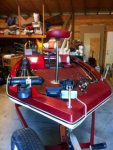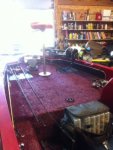terry 5.2m
Cadet
- Joined
- Jul 30, 2012
- Messages
- 26
Hello all,
New to the forum and I have been trying to search and educate myself as much as possible before posting thie, however, it is becoming a little overwhelming.
I have a 1978 Terry 5.2M with a 1977 Johnson 115ETL77S.
The boat is in what I feel to be good condition but the motor needs some TLC.
I just purchased the boat last Sunday. While on the test drive I noticed the idle was rough but at WOT it hummed around pretty good and I didnt notice any missing, hesitation etc. granted I am by no means an OB expert.
At idle however, it is a different story. The high speed idle needs to be engaged for it to stay idling.
I purchased the boat based on faith that it just needed some TLC. The person I bought the boat from said he couldn't remember when he had it out last but has it running on muffs July 4th weekend.
So last night I bought a transfer pump and removed all the gas from the tank. I also disconnected the fuel line to the motor, removed the connection and used the prime bulb to make sure I had all the gas out of the tank. The first gal I put into a milk jug and after letting it settle there was indeed water in the gas or it had seperated....maybe 8oz worth. I continued to pump the gas out and towards the end I put some more gas in a different milk jug to see if there was more water. At this point the gas was form what I could tell clean. This makes sense as water is heavier than oil/gas and the boat is on the jack wheel jacked as high as it could go so the gas would fall toward the primer tube as it neared the end.
This bring me to my "what I wanna hear" question.
1. Do I need to rebuild the carbs? Or can I refill with fresh 50:1 mixture, hook up to muffs and see what I got. The plugs are pretty black so I was going to clean them first and double check the gap to be 0.03. I also have carb cleaner I was going to spray into the carbs while the engine was running. I also have a can of "Tuner" Carbon cleaner.
2. I want to check the water flow for the pump/impeller. The guy I bought it from said he replaced the impeller and fluid this season but I still wish to verify. On this older model from what I have read the water comes out of the exhaust ports and/or the prop area (telltale?). This is where I am fuzzy. I bought a Solec (I know the O&M is the best way to go) and it mentions to be carful not to have >45psi on the muffs. I am going to use a std home, city water supplied, garden hose. To my knowledge I do not have a pressure gauge but I will double check.
a. Is this a true concern? I had though about buying a water trough from TSC to submerse the motor as I think that would exhibit a more accurate load.
b. Where should I see water exiting and how strong of a stream should I have? I do not have a temp gun to monitor the head temp.
If it ran good at WOT do I need to be concerned with compression check?
thanks in advance and I apologize for the long post.
PS see attached pics of boa...hardly anyone including myself has ever heard of a Terry.
Scott
New to the forum and I have been trying to search and educate myself as much as possible before posting thie, however, it is becoming a little overwhelming.
I have a 1978 Terry 5.2M with a 1977 Johnson 115ETL77S.
The boat is in what I feel to be good condition but the motor needs some TLC.
I just purchased the boat last Sunday. While on the test drive I noticed the idle was rough but at WOT it hummed around pretty good and I didnt notice any missing, hesitation etc. granted I am by no means an OB expert.
At idle however, it is a different story. The high speed idle needs to be engaged for it to stay idling.
I purchased the boat based on faith that it just needed some TLC. The person I bought the boat from said he couldn't remember when he had it out last but has it running on muffs July 4th weekend.
So last night I bought a transfer pump and removed all the gas from the tank. I also disconnected the fuel line to the motor, removed the connection and used the prime bulb to make sure I had all the gas out of the tank. The first gal I put into a milk jug and after letting it settle there was indeed water in the gas or it had seperated....maybe 8oz worth. I continued to pump the gas out and towards the end I put some more gas in a different milk jug to see if there was more water. At this point the gas was form what I could tell clean. This makes sense as water is heavier than oil/gas and the boat is on the jack wheel jacked as high as it could go so the gas would fall toward the primer tube as it neared the end.
This bring me to my "what I wanna hear" question.
1. Do I need to rebuild the carbs? Or can I refill with fresh 50:1 mixture, hook up to muffs and see what I got. The plugs are pretty black so I was going to clean them first and double check the gap to be 0.03. I also have carb cleaner I was going to spray into the carbs while the engine was running. I also have a can of "Tuner" Carbon cleaner.
2. I want to check the water flow for the pump/impeller. The guy I bought it from said he replaced the impeller and fluid this season but I still wish to verify. On this older model from what I have read the water comes out of the exhaust ports and/or the prop area (telltale?). This is where I am fuzzy. I bought a Solec (I know the O&M is the best way to go) and it mentions to be carful not to have >45psi on the muffs. I am going to use a std home, city water supplied, garden hose. To my knowledge I do not have a pressure gauge but I will double check.
a. Is this a true concern? I had though about buying a water trough from TSC to submerse the motor as I think that would exhibit a more accurate load.
b. Where should I see water exiting and how strong of a stream should I have? I do not have a temp gun to monitor the head temp.
If it ran good at WOT do I need to be concerned with compression check?
thanks in advance and I apologize for the long post.
PS see attached pics of boa...hardly anyone including myself has ever heard of a Terry.
Scott























